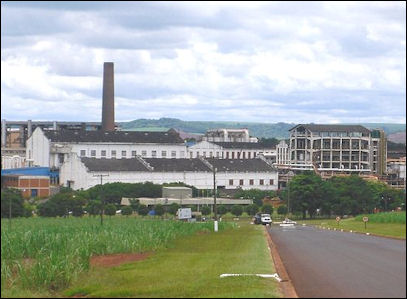TYPES OF SUGAR
large sugar mill in BrazilCentrifugal Sugar is sugar separated from liquid by a centrifugal machine. Non-centrifugal cane sugar (NCS) is the technical name of raw sugar obtained by evaporating water from sugarcane juice. Refined sugar comes from sugar cane or sugar beets, which have been processed to extract the sugar. It typically comes in the form of sucrose — the combination of glucose and fructose.
Glucose is the main sugar in human blood. It comes from the food people eat, and is the body's main source of energy. It can be derived from a variety of foods. Dextrose is a simple sugar made from corn or wheat that's chemically identical to glucose. Dextrose is often used in baking.
Fructose is a sugar found naturally in fruits, fruit juices, some vegetables and honey. It is often a basic component in table sugar (sucrose), and high-fructose corn syrup is used to sweeten many processed foods and beverages.
Molasses is the thick, dark brown juice obtained from raw sugar during the refining process. Brown sugar has molasses in it, which gives it a little richer flavor. White sugar has no molasses and is just sweet. Both white and brown sugars are used to sweeten cakes, candy, cookies, coffee, cereal and a host of processed foods
World’s Top Sugar Producing and Exporting Countries
Brazil and India are the world’s largest producers of sugar.
World’s Top Producers of Raw Centrifugal Sugar (2019): 1) India: 34300000 tonnes; 2) Brazil: 27732026 tonnes; 3) Thailand: 14866800 tonnes; 4) China: 11760000 tonnes; 5) United States: 7374045 tonnes; 6) Russia: 7309657 tonnes; 7) Mexico: 6710121 tonnes; 8) France: 4897000 tonnes; 9) Pakistan: 4881225 tonnes; 10) Australia: 4516700 tonnes; 11) Guatemala: 2962554 tonnes; 12) Egypt: 2600000 tonnes; 13) Turkey: 2494132 tonnes; 14) South Africa: 2295000 tonnes; 15) Indonesia: 2258133 tonnes; 16) Colombia: 2203982 tonnes; 17) Philippines: 2036600 tonnes; 18) Argentina: 1893000 tonnes; 19) Vietnam: 1812800 tonnes; 20) Ukraine: 1489972 tonnes. [Source: FAOSTAT, Food and Agriculture Organization (U.N.), fao.org. A tonne (or metric ton) is a metric unit of mass equivalent to 1,000 kilograms (kgs) or 2,204.6 pounds (lbs). A ton is an imperial unit of mass equivalent to 1,016.047 kg or 2,240 lbs.]
small rural sugar plant
World’s Top Exporters of Raw Centrifugal Sugar (2020): 1) Brazil: 26675030 tonnes; 2) Australia: 3258919 tonnes; 3) Thailand: 3020171 tonnes; 4) India: 1674727 tonnes; 5) Guatemala: 824463 tonnes; 6) Eswatini: 702900 tonnes; 7) South Africa: 671376 tonnes; 8) Cuba: 597736 tonnes; 9) Mexico: 549076 tonnes; 10) El Salvador: 531806 tonnes; 11) Nicaragua: 282683 tonnes; 12) Belize: 282444 tonnes; 13) Colombia: 277237 tonnes; 14) Dominican Republic: 211786 tonnes; 15) Costa Rica: 168121 tonnes; 16) Zambia: 167133 tonnes; 17) Russia: 163220 tonnes; 18) Mauritius: 144642 tonnes; 19) Fiji: 142515 tonnes; 20) Zimbabwe: 138141 tonnes
World’s Top Exporters (in value terms) of Raw Centrifugal Sugar (2020): 1) Brazil: US$7380739,000; 2) Australia: US$1019435,000; 3) Thailand: US$884869,000; 4) India: US$558905,000; 5) Eswatini: US$375002,000; 6) Mexico: US$287850,000; 7) Guatemala: US$267982,000; 8) South Africa: US$234743,000; 9) Cuba: US$188621,000; 10) El Salvador: US$187663,000; 11) Colombia: US$142476,000; 12) Dominican Republic: US$112631,000; 13) Nicaragua: US$93788,000; 14) Mauritius: US$89694,000; 15) Zambia: US$85184,000; 16) Malawi: US$73981,000; 17) Zimbabwe: US$73509,000; 18) Russia: US$67864,000; 19) Costa Rica: US$64182,000; 20) Philippines: US$62957,000
World’s Top Refined Sugar Exporting Countries
World’s Top Exporters of Refined Sugar (2020): 1) India: 5386933 tonnes; 2) Brazil: 3960898 tonnes; 3) Thailand: 2362500 tonnes; 4) France: 2161732 tonnes; 5) United Arab Emirates: 1433392 tonnes; 6) Germany: 1221579 tonnes; 7) Russia: 1029249 tonnes; 8) Guatemala: 841042 tonnes; 9) Morocco: 648167 tonnes; 10) Netherlands: 604051 tonnes; 11) Poland: 585174 tonnes; 12) Belgium: 519473 tonnes; 13) Algeria: 509351 tonnes; 14) Colombia: 483487 tonnes; 15) Belarus: 445197 tonnes; 16) South Africa: 346693 tonnes; 17) Saudi Arabia: 317487 tonnes; 18) South Korea: 314106 tonnes; 19) Djibouti: 280000 tonnes; 20) Mexico: 273474 tonnes. [Source: FAOSTAT, Food and Agriculture Organization (U.N.), fao.org]
World’s Top Exporters (in value terms) of Refined Sugar (2020): 1) India: US$1935741,000; 2) Brazil: US$1363449,000; 3) France: US$964069,000; 4) Thailand: US$877400,000; 5) Germany: US$611634,000; 6) United Arab Emirates: US$582913,000; 7) Russia: US$393620,000; 8) Netherlands: US$337670,000; 9) Guatemala: US$311778,000; 10) Morocco: US$287346,000; 11) Belgium: US$273989,000; 12) Poland: US$267298,000; 12) Colombia: US$222687,000; 14) Mexico: US$197099,000; 15) Algeria: US$196389,000; 16) Saudi Arabia: US$162724,000; 17) Belarus: US$151825,000; 18) United Kingdom: US$149892,000; 19) South Korea: US$138148,000; 20) South Africa: US$136012,000
Sugar Consumption
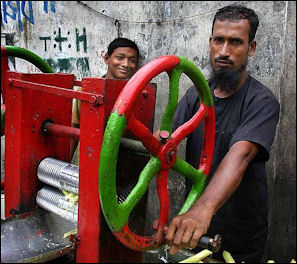
Sugarcane juice vendorIn 2005, 136 billion kilograms (300 billion) pounds of sugar was consumed worldwide. The United States is by far the largest consumer of sugar. The average American consumed 64 kilograms (140 pounds) of sugar, corn syrup and other natural sweeteners in 2005, up from 52 kilograms (114 pounds) in 1967 and 50 percent more than the French and Germans and nine times more than the Chinese. American also consume 61 pounds of high-fructose corn syrup a year.
World’s Top Importers of Refined Sugar (2020): 1) Sudan: 1462409 tonnes; 2) Italy: 1314987 tonnes; 3) United States: 1178659 tonnes; 4) Spain: 889129 tonnes; 5) Somalia: 641871 tonnes; 6) China: 608274 tonnes; 7) Iran: 605256 tonnes; 8) Sri Lanka: 579335 tonnes; 9) Yemen: 560896 tonnes; 10) Germany: 560013 tonnes; 11) Afghanistan: 507451 tonnes; 12) Vietnam: 477837 tonnes; 13) Belgium: 471202 tonnes; 14) Ghana: 433006 tonnes; 15) Kazakhstan: 416005 tonnes; 16) Chile: 410472 tonnes; 17) Mauritania: 404418 tonnes; 18) Cambodia: 381980 tonnes; 19) Uzbekistan: 367318 tonnes; 20) Djibouti: 343259 tonnes. [Source: FAOSTAT, Food and Agriculture Organization (U.N.), fao.org]
World’s Top Importers (in value terms) of Refined Sugar (2020): 1) United States: US$821757,000; 2) Italy: US$632934,000; 3) Sudan: US$616782,000; 4) Spain: US$456588,000; 5) Vietnam: US$432667,000; 6) Germany: US$311344,000; 7) China: US$264293,000; 8) Belgium: US$248973,000; 9) Somalia: US$243000,000; 10) Iran: US$233494,000; 11) Sri Lanka: US$230746,000; 12) Yemen: US$215523,000; 13) France: US$179661,000; 14) Afghanistan: US$178059,000; 15) Chile: US$168525,000; 16) Mauritania: US$166742,000; 17) Ghana: US$165440,000; 18) Jordan: US$162677,000; 19) Cambodia: US$159572,000; 20) Kazakhstan: US$159101,000
Sugar Processing

inside a sugar plant On a small scale unprocessed sugar cane is usually put in a machine that squeezes a brown juice out of the stalks. The machine can be operated by a couple of oxen going around and around in a circle, a noisy motor, and a simple hand press. The juice can be consumed straight, turned into sugar and molasses, steamed and smoked into brown sugar or fermented into rum or some other strong alcoholic drink. The scum from the steaming sugar is fed to the pigs. The stalks are saved for fodder and fertilizer.
The production of sugar in a sugar mill has been described as a "noisy, steamy, hellish process" that produces "hundred pound bags of granulated sweetness." Sugar cane is crushed and squeezed under great pressure by heavy metal rollers, powered by steam turbines. The juice is collected in pans below the rollers. The fiber is squeezed so thoroughly it is dry enough to be used as fuel to fire the mill's boilers.
The juice is then treated in different ways to remove impurities and processed into molasses and white grains using boiling chambers. The molasses-and-grain mixture is separated into molasses and grain in centrifuge.
Raw sugar is light brown and slightly sticky from lingering molasses. Further refining is necessary. This involves treating the raw sugar to remove molasses, dissolving the crystals in warm water, filtering the resulting syrup for impurities, recrystallizing the sugar in vacuum pans and washing and drying it. The sugar is then placed in graduated copper kettles for granulating.
In February 2008, eight people were killed in an explosion at a sugar refinery in Port Wentworth, Georgia. The blast occurred in a sugar storage silo or bagging room. Volatile sugar dust is believed to have contributed to the blast.
World’s Top Molasses Producing and Exporting Countries
World’s Top Producers of Molasses (2019): 1) India: 14100000 tonnes; 2) Brazil: 12295000 tonnes; 3) Thailand: 5876000 tonnes; 4) China: 3800000 tonnes; 5) Pakistan: 2235000 tonnes; 6) United States: 2228000 tonnes; 7) Mexico: 2190000 tonnes; 8) Russia: 1635615 tonnes; 9) Indonesia: 1275000 tonnes; 10) Philippines: 1170000 tonnes; 11) Australia: 1000000 tonnes; 12) Egypt: 940000 tonnes; 13) South Africa: 905000 tonnes; 14) Turkey: 890000 tonnes; 15) Guatemala: 717889 tonnes; 16) Argentina: 575000 tonnes; 17) Ukraine: 555120 tonnes; 18) Peru: 525000 tonnes; 19) Cuba: 520000 tonnes; 20) Vietnam: 460000 tonnes. [Source: FAOSTAT, Food and Agriculture Organization (U.N.), fao.org]
World’s Top Exporters of Molasses (2020): 1) India: 737116 tonnes; 2) Russia: 716334 tonnes; 3) Germany: 494305 tonnes; 4) Guatemala: 444619 tonnes; 5) Indonesia: 430707 tonnes; 6) Thailand: 379205 tonnes; 7) Poland: 324707 tonnes; 8) El Salvador: 295921 tonnes; 9) Egypt: 247834 tonnes; 10) Australia: 203439 tonnes; 11) Nicaragua: 141386 tonnes; 12) Netherlands: 138573 tonnes; 13) Dominican Republic: 126312 tonnes; 14) Honduras: 114608 tonnes; 15) Belarus: 113811 tonnes; 16) Belgium: 105066 tonnes; 17) Belize: 92902 tonnes; 18) Iran: 90000 tonnes; 19) Myanmar: 75409 tonnes; 20) United States: 73410 tonnes
World’s Top Exporters (in value terms) of Molasses (2020): 1) India: US$102136,000; 2) Germany: US$82513,000; 3) Indonesia: US$76291,000; 4) Russia: US$76016,000; 5) Guatemala: US$71422,000; 6) Thailand: US$61040,000; 7) Poland: US$44868,000; 8) Egypt: US$40092,000; 9) El Salvador: US$38426,000; 10) United States: US$31161,000; 11) Netherlands: US$28292,000; 12) Australia: US$27035,000; 13) Honduras: US$23915,000; 14) United Kingdom: US$19518,000; 15) Nicaragua: US$17942,000; 16) Dominican Republic: US$17516,000; 17) Belgium: US$14054,000; 18) Taiwan: US$10861,000; 19) Morocco: US$10063,000; 20) Fiji: US$9456,000
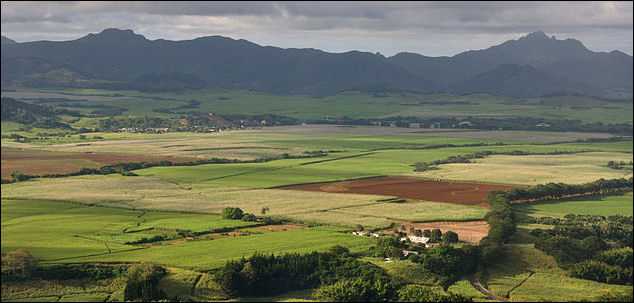
sugar cane in Mauritius
World’s Top Molasses Importing Countries
World’s Top Importers of Molasses (2020): 1) United Kingdom: 491189 tonnes; 2) Philippines: 477822 tonnes; 3) Turkey: 449830 tonnes; 4) United States: 446806 tonnes; 5) South Korea: 404585 tonnes; 6) Belgium: 306323 tonnes; 7) Thailand: 267740 tonnes; 8) Canada: 230422 tonnes; 9) Spain: 225184 tonnes; 10) France: 208995 tonnes; 11) Italy: 204207 tonnes; 12) Netherlands: 199347 tonnes; 13) Ireland: 147820 tonnes; 14) Japan: 137535 tonnes; 15) Hungary: 120955 tonnes; 16) Vietnam: 117733 tonnes; 17) Germany: 112845 tonnes; 18) South Africa: 89852 tonnes; 19) Indonesia: 80707 tonnes; 20) Norway: 76677 tonnes. [Source: FAOSTAT, Food and Agriculture Organization (U.N.), fao.org]
World’s Top Importers (in value terms) of Molasses (2020): 1) United States: US$174191,000; 2) Philippines: US$101179,000; 3) United Kingdom: US$101142,000; 4) South Korea: US$77931,000; 5) Turkey: US$72330,000; 6) Belgium: US$50489,000; 7) Vietnam: US$48346,000; 8) Thailand: US$44907,000; 9) France: US$38210,000; 10) Spain: US$38143,000; 11) Italy: US$37377,000; 12) Netherlands: US$37185,000; 13) Japan: US$33563,000; 14) Canada: US$33376,000; 15) Ireland: US$30495,000; 16) Germany: US$19024,000; 17) Indonesia: US$18449,000; 18) Hungary: US$14372,000; 19) Norway: US$14270,000; 20) Australia: US$13525,000
Sugar Products
Sugar products include brown sugar, granulated sugar, confectionery sugar, caramel, molasses, sugar cubes, syrup. It is used in making cakes, soft drinks, candy and wide variety of other foods. Sugar cane can be made into sugar-based ethanol which can be mixed with gasoline to power cars.
Sugar has lost a lot of business to high-fructose corn syrup which was developed in the 1970s and is the main sweetener in Coca Cola and other soft drinks as well as in things like salad dressing.
.JPG)
burning sugar fields
A great deal of time and money has been spent on trying to come up with low or no calorie sugar substitutes. The ones that have been devised so far include sucralose, or Splenda; a DDT-like chemical with lots of chlorine molecules developed in the 1970s in Britain by adding several toxic chemicals to sugar; saccharin, used in Sweet’N low, synthesized in 1879 by a chemist working with tar-coal derivatives; and Aspartame, used in Nutrasweet’s Equal and most diet sodas, developed by scientists looking for drugs to treat gastric ulcer. Another promising sweetener, super-aspartame, has a chemical structure similar to cyanide.
Saccharine accounts for 60 percent of world market for artificial sweeteners, followed by aspartame with 20 percent, and Sucralose with five percent. Work is still being done on creating better artificial sweeteners — including ones derived from the South American shrub stevia and the West African katemfe fruit — but none of them are very good or come close to matching sugars sweetness. Perhaps the closest, Tagatosem a derivative of lactose, has a taste close to that of sugar but acts as a laxative even if consumed in moderate amounts. Many companies have given up on finding a replacement for sugar and rather are concentrating on mixing artificial sweeteners with sugar to develop low-calorie sugar.
World’s Top Sugar Confectionary Exporting and Importing Countries
World’s Top Exporters of Sugar Confectionery (2020): 1) Germany: 333919 tonnes; 2) China: 292904 tonnes; 3) Mexico: 271518 tonnes; 4) Belgium: 221028 tonnes; 5) Turkey: 220480 tonnes; 6) Spain: 195505 tonnes; 7) Netherlands: 170209 tonnes; 8) Canada: 132707 tonnes; 9) United States: 125614 tonnes; 10) Poland: 110296 tonnes; 11) Ukraine: 100430 tonnes; 12) Russia: 91747 tonnes; 13) India: 84760 tonnes; 14) Brazil: 83191 tonnes; 15) Colombia: 67416 tonnes; 16) Iran: 60000 tonnes; 17) Czechia: 56558 tonnes; 18) South Korea: 55926 tonnes; 19) United Kingdom: 53550 tonnes; 20) Italy: 44071 tonnes. [Source: FAOSTAT, Food and Agriculture Organization (U.N.), fao.org]
World’s Top Exporters (in value terms) of Sugar Confectionery (2020): 1) Germany: US$1313690,000; 2) China: US$868848,000; 3) Belgium: US$715595,000; 4) Netherlands: US$694674,000; 5) Mexico: US$680771,000; 6) Spain: US$566502,000; 7) Turkey: US$484360,000; 8) Poland: US$460326,000; 9) United States: US$453149,000; 10) Canada: US$436501,000; 11) United Kingdom: US$246005,000; 12) France: US$197122,000; 13) Italy: US$196771,000; 14) Russia: US$178579,000; 15) Czechia: US$172323,000; 16) Iran: US$170000,000; 17) Ukraine: US$169227,000; 18) Switzerland: US$149172,000; 19) Thailand: US$147189,000; 20) Denmark: US$146807,000
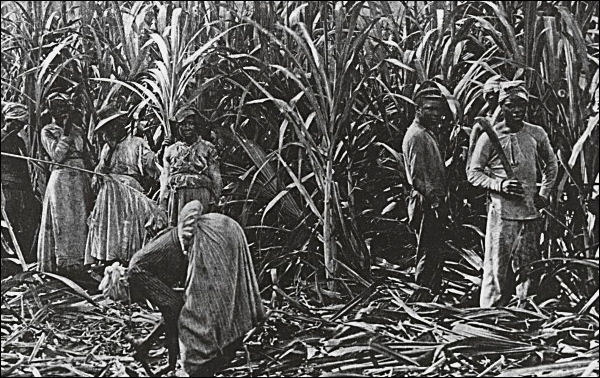
Harvesting sugar cane in Georgia in the old days
World’s Top Importers of Sugar Confectionery (2020): 1) United States: 700544 tonnes; 2) United Kingdom: 191728 tonnes; 3) Germany: 185521 tonnes; 4) Canada: 134672 tonnes; 5) Netherlands: 124713 tonnes; 6) France: 102499 tonnes; 7) Belgium: 87216 tonnes; 8) Sweden: 73334 tonnes; 9) Poland: 73178 tonnes; 10) Russia: 68508 tonnes; 11) Saudi Arabia: 57799 tonnes; 12) China: 48463 tonnes; 13) South Korea: 43383 tonnes; 14) Australia: 42522 tonnes; 15) Yemen: 42481 tonnes; 16) Nigeria: 41330 tonnes; 17) Kazakhstan: 39239 tonnes; 18) Philippines: 38992 tonnes; 19) South Africa: 37970 tonnes; 20) Italy: 37483 tonnes. [Source: FAOSTAT, Food and Agriculture Organization (U.N.), fao.org]
World’s Top Importers (in value terms) of Sugar Confectionery (2020): 1) United States: US$2001947,000; 2) Germany: US$740569,000; 3) United Kingdom: US$609554,000; 4) Netherlands: US$438889,000; 5) Canada: US$398308,000; 6) France: US$392954,000; 7) Belgium: US$309153,000; 8) China: US$267427,000; 9) Saudi Arabia: US$250478,000; 10) Poland: US$249685,000; 11) Sweden: US$237630,000; 12) South Korea: US$222381,000; 13) Australia: US$189982,000; 14) Russia: US$174532,000; 15) United Arab Emirates: US$162286,000; 16) Italy: US$137181,000; 17) Austria: US$137143,000; 18) Hong Kong: US$135334,000; 19) Spain: US$126609,000; 20) Denmark: US$124902,000
World’s Top Wafer Exporting and Importing Countries
World’s Top Exporters of Wafers (2020): 1) Germany: 505163 tonnes; 2) Indonesia: 141231 tonnes; 3) Italy: 141050 tonnes; 4) Turkey: 137119 tonnes; 5) Poland: 117224 tonnes; 6) Belgium: 72163 tonnes; 7) Canada: 68733 tonnes; 8) Austria: 67401 tonnes; 9) Russia: 66644 tonnes; 10) Netherlands: 54213 tonnes; 11) Philippines: 44855 tonnes; 12) United States: 43850 tonnes; 13) Bulgaria: 27373 tonnes; 14) Ukraine: 21950 tonnes; 15) Brazil: 19372 tonnes; 16) Czechia: 17875 tonnes; 17) United Kingdom: 16589 tonnes; 18) China: 14592 tonnes; 19) Malaysia: 13393 tonnes; 20) Romania: 11851 tonnes. [Source: FAOSTAT, Food and Agriculture Organization (U.N.), fao.org]
World’s Top Exporters (in value terms) of Wafers (2020): 1) Germany: US$993943,000; 2) Italy: US$700110,000; 3) Poland: US$628840,000; 4) Canada: US$359028,000; 5) Indonesia: US$338087,000; 6) Turkey: US$337829,000; 7) Belgium: US$245830,000; 8) Netherlands: US$217025,000; 9) Austria: US$197148,000; 10) Russia: US$118017,000; 11) Philippines: US$108765,000; 12) United States: US$94883,000; 13) Bulgaria: US$93685,000; 14) United Kingdom: US$84354,000; 15) Czechia: US$71406,000; 16) Ukraine: US$58524,000; 17) France: US$53939,000; 18) Malaysia: US$46422,000; 19) Brazil: US$42358,000; 20) China: US$36931,000
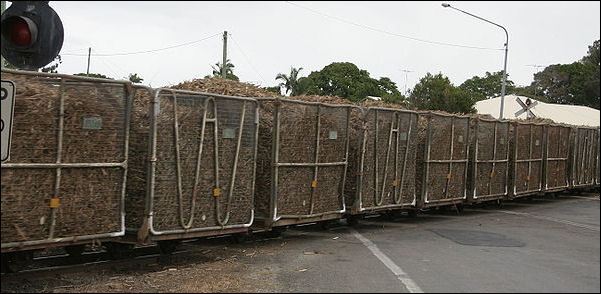
sugar cane mill_tram
World’s Top Importers of Wafers (2020): 1) Germany: 230348 tonnes; 2) Canada: 224318 tonnes; 3) United States: 122515 tonnes; 4) Italy: 118671 tonnes; 5) Philippines: 72806 tonnes; 6) Austria: 63313 tonnes; 7) Iraq: 62103 tonnes; 8) France: 60114 tonnes; 9) United Kingdom: 51761 tonnes; 10) China: 49182 tonnes; 11) Romania: 39644 tonnes; 12) Saudi Arabia: 30640 tonnes; 13) Netherlands: 24686 tonnes; 14) Czechia: 22498 tonnes; 15) Myanmar: 20694 tonnes; 16) Spain: 19414 tonnes; 17) Poland: 18778 tonnes; 18) Belgium: 16926 tonnes; 19) Jordan: 15895 tonnes; 20) Kazakhstan: 15444 tonnes
World’s Top Importers (in value terms) of Wafers (2020): 1) Canada: US$656875,000; 2) Germany: US$615403,000; 3) United States: US$597746,000; 4) Italy: US$275582,000; 5) France: US$262495,000; 6) United Kingdom: US$234105,000; 7) Philippines: US$198860,000; 8) Saudi Arabia: US$173295,000; 9) Iraq: US$162446,000; 10) Austria: US$151822,000; 11) China: US$148097,000; 12) Romania: US$112192,000; 13) Netherlands: US$100626,000; 14) Spain: US$88601,000; 15) Czechia: US$85500,000; 16) Belgium: US$82275,000; 17) Poland: US$78824,000; 18) Mexico: US$65873,000; 19) Australia: US$54890,000; 20) Thailand: US$54416,000
Sugar Biofuel
Bioethenal is usually made from corn, soy or sugar cane and is good for the environment in that it produces low levels of carbon dioxide. Sugar cane yields eight times more energy than corn and makes up 40 percent of all the fuel sold in Brazil.
Biofuel made with sugar is cheaper to make and produces more energy than biofuel made with corn. Biofuel sources (gallons per acre): 1) sugar beets (714); 2) sugar cane (662); 3) cassava (410); 4) sorghum (374); 5) corn (354).
Ethanol made mostly from sugar cane is widely used in Brazil. Many developed countries are subsidizing home grown biofuel sources while blocking cheaper Brazilian ethanol, which is far less damaging to global food security.
There are two main kinds of ethanol: 1) corn ethanol derived from corn, sugar cane and soy beans; and 2) cellulosic ethanol derived from plants like switchgrass (summer grass) , wood chips, agricultural wastes such as stalks and leaves and husks, forest waste such as bark and sawdust, paper pulp and timber chip. The latter produces more energy than corn ethanol but takes more energy to manufacture.
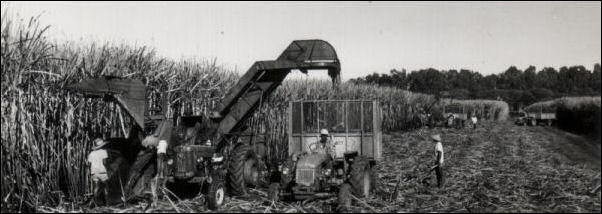
Sugar is better than corn as a bioethenal source. It yields 600 to 800 gallons an acre, twice as much as corn. Sugar cane stalks are 20 percent sugar, negating the need for expensive enzymes to change starch to sugar, and they start to ferment almost as soon as they are cut. Waste cane can be burned to provide heat for distillation, reducing the burning of fossil fuels. Sugar-based ethanol produces 80 percent less carbon dioxide than gasoline.
One massive sugar cane refinery in Pradopolis, Brazil — one of the largest ethanol factories in the world — turns seven million tons of sugar cane into 300 million liters of ethanol each year. It is very efficient, using sugarcane waste, known as bagasse, for power and recycling wastewater for fertilizer. Using the sugar cane biomass for electricity and heat, the plant produces eight units of ethanol for every unit of fossil fuels it uses.
Sugar Business
The world's number one sugar trader is a company called ED&F Man. It controls about 15 percent of the world's market. When prices are low it and other traders suffer. They also can lose great amounts of money speculating on futures. Tate & Lyle is another large trader.
The price of sugar rose around 300 percent between 2000 and 2009, reaching a 28-year high of 22.4 cents a kilogram over supply concerns caused by too much rain in Brazil, the world’s largest producer, and not enough rain caused by poor monsoons in India, the world’s second largest producer, as well as strong demand for it as a biofuel.
In February 2006, sugar prices reached a 20 year high of 19 cents a pound (42 cents a kilogram), up from 17 cents a pound in 2005. The high rices were attributed to high oil prices and increased demand for sugar to make ethanol and increased demand from China. The global demand for sugar reached 145.7 million tons. Prices had shrunk to 5 cents a pound in 2000.
Unfair Sugar Industry
Sugar agriculture and industry are notoriously unfair. Workers often are paid peanuts, live in horrid condition and work like slaves while owners and producers live like kings. Even worse is the fact that many rich growers receive generous subsidies from government in rich counties, hurting sugar producers in poor countries.
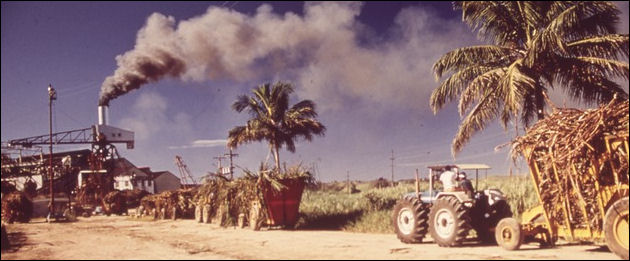
In the United States and Europe, sugar farmers have traditionally received considerable support from governments in the form of subsidies and laws and tariffs that limit the amount of foreign imports. In the United States, the lack of competition has allowed sugar producers to sell their crop for double the world price. Farmers in the European Union are protected by tariffs. If there is a surplus the government buy it at artificially high prices and export it at artificially low prices. Sugar producers in poor countries who don’t receive subsidies can’t compete.
Support of the American and European sugar industries are being threatened by the Central America Free Trade Agreement and agreements by the WTO.
Image Sources: Wikimedia Commons
Text Sources: National Geographic, New York Times, Washington Post, Los Angeles Times, Smithsonian magazine, Natural History magazine, Discover magazine, Times of London, The New Yorker, Time, Newsweek, Reuters, AP, AFP, Lonely Planet Guides, Compton’s Encyclopedia and various books and other publications.
Last updated March 2022

